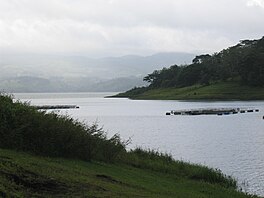
Summary
Lake Arenal (Spanish: Lago Arenal) is a lake in the northern highlands of Costa Rica. It is the largest lake in Costa Rica at 85-square-kilometre (33 sq mi). Its depth varies between 30 and 60 meters (100–200 feet) seasonally.[2]
| Lake Arenal | |
|---|---|
 A view from the southwest side looking across at the north depth 30–60 m (98–197 ft) | |
 Lake Arenal Location in Costa Rica | |
| Location | Alajuela and Guanacaste Provinces, Costa Rica |
| Coordinates | 10°30′19″N 84°52′20″W / 10.505167°N 84.872168°W |
| Max. length | 30 kilometres (19 mi) |
| Max. width | 5 kilometres (3.1 mi) |
| Surface area | 85 square kilometres (33 sq mi) |
| Max. depth | 100 metres (330 ft) |
| Islands | Isla Arenal |
| Settlements | Nuevo Arenal, Tronadora |
| Official name | Cuenca Embalse Arenal |
| Designated | 7 March 2000 |
| Reference no. | 1022[1] |
Originally a natural lake, Lake Arenal was tripled in size with the 1979 construction of the Presa Sangregado Dam at its northern end. All land below the 550-meter level was expropriated by the Costa Rican government. The old towns of Arenal and Tronadora now lie at the bottom of the lake; their residents were resettled in the new town of Arenal to the northeast. The dam also displaced a large cattle operation, Hacienda La Rosita, which was owned and operated by P. Eckrich & Sons, a subsidiary of the U.S. corporation Beatrice Foods.[3] Hacienda La Rosita occupied most of the land that is now Lake Arenal as well as additional land surrounding the lake.
Hydroelectricity edit
The Presa Sangregado Dam hydroelectric project at the western end of the lake is strategically important to Costa Rica. It initially generated 70% of the country's electricity, though now closer generates closer to 17%. It was a driving force behind Costa Rica's green energy policy.[4]
Wildlife edit
Fish species in Lake Arenal include the machaca and the rainbow bass. There are also many species of plants, 120 of mammals (including jaguar and tapir), and 300 of birds (including quetzal).
Recreation edit
From November through April the strong, dependable winds attract windsurfers and kite surfers to its western end.[5] Many consider Lake Arenal one of the world's foremost windsurfing and kite surfing areas. Wakeboarding is gaining popularity in Costa Rica, with Lake Arenal being the center of this activity. Stand up paddling[6] and kayaking are also popular activities for tourists visiting the lake's Eastern part near the earthen dam. There is much good fishing (primarily for rainbow bass) and now kayak fishing opportunities in the shallow and secluded coves. The area surrounding the lake has good hiking, biking, bird watching, and horseback riding opportunities.[7]
Gallery edit
-
-
hydro-electricity on Lake Arenal.
-
Wind power plant of Tierras Morenas, around Lake Arenal.
-
-
-
-
Horse grazing on the shore of the Lake with the Arenal Volcano in the background.
-
View of the lake from the village of El Fosforo, on the southeastern shore.
References edit
- ^ "Cuenca Embalse Arenal". Ramsar Sites Information Service. Retrieved 25 April 2018.
- ^ Stater, Adam. "Lake Arenal Depth".
- ^ https://www.beatriceco.com/bti/porticus/beatrice/pdf/1972BFar_Complete.pdf
- ^ Pérez, Carlos (2006-12-13). "Minutes of the Workshop on Adaptation to Climate Change in Costa Rica. Results of the Event". San José, Costa Rica: Trofcca Central America. Archived from the original (DOC) on 2011-05-18. Retrieved 2019-10-02.
{{cite journal}}: Cite journal requires|journal=(help) - ^ "Lake Arenal Costa Rica Tico Wind Windsurf Center - Windsurfing Kiteboarding Rentals Lessons". Retrieved 2015-10-07.
- ^ "Costa Rica Stand Up Paddling Tours". www.desafiocostarica.com. Retrieved 2016-01-04.
- ^ Stater, Adam. "Lake Arenal Activities".
lake arenal fishing.https://arenalfishing.com/
External links edit
https://arenalfishing.com/
- Lake Arenal information
- Lake Arenal information about wind and water
- Lake Arenal information about rainforest, mountains and lake
- Lake Arenal information about transportation


